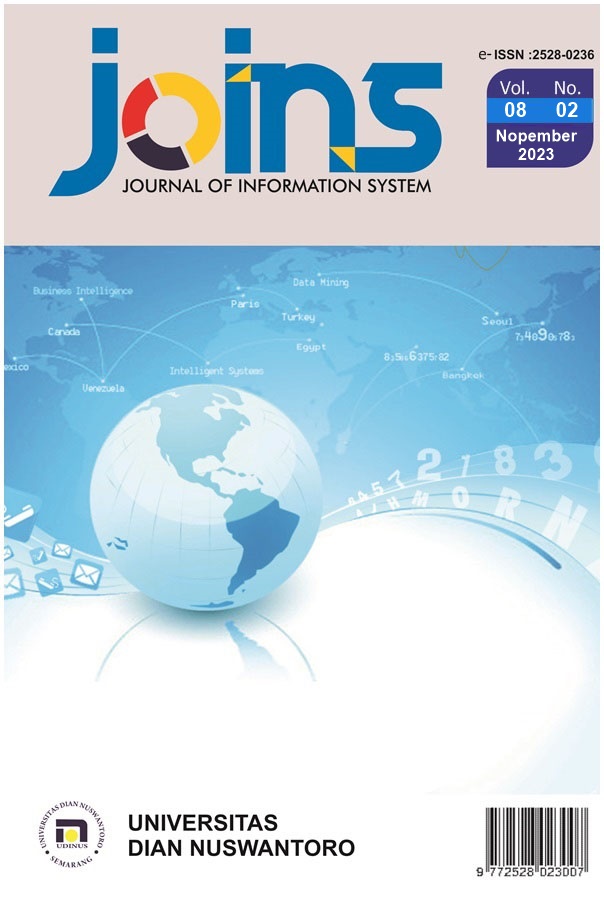Sistem Automasi Zero Touch Provisioning Routerboard Berbasis GraphQL API
DOI:
https://doi.org/10.33633/joins.v8i2.8535Keywords:
network automation, routerboard, graphQL, automasi, pythonAbstract
Dalam sistem perangkat jaringan modern, idealnya sebuah perangkat jaringan memiliki manajemen sistem yang terpusat. Sistem manajemen terpusat yang baik memiliki kemampuan tidak sekedar monitoring, melainkan juga provisioning dan kegiatan administratif lain. Permasalahan yang dihadapi yakni perangkat jaringan routerboard tidak mampu melakukan provisioning secara mandiri dan otomatis. Untuk mengatasi masalah tersebut, perlu adanya sebuah sistem manajemen modern yang mampu melakukan provisioning secara otomatis, monitoring, dan juga administrasi konfigurasi secara massal. Dengan melakukan observasi dan studi literatur diketahui penggunaan routerboard dapat dimaksimalkan dengan fitur command line berupa HTTP request dan pemanfaatan arsitektur API. Penelitian ini mampu membuat sistem automasi zero touch provisioning routerboard, dengan menggunakan framework PHP Laravel dan GraphQL API. Hasil penelitian membuktikan bahwa sistem automasi mampu melakukan zero touch provisioning dengan memanfaatkan command line HTTP request untuk routerboard berkomunikasi ke server controller. Sedangkan untuk administrasi konfigurasi antara server controller ke routerboard, dilakukan melalui proses pemanggilan API. Pengujian yang dilakukan menunjukkan bahwa rata-rata durasi yang dibutuhkan dalam proses zero touch provisioning routerboard yakni 8.851ms.References
B. K. Simpony, “Simple Queue Untuk Manajemen User dan Bandwidth di Jaringan Hotspot Menggunakan Mikrotik,” JURNAL INFORMATIKA, vol. 8, no. 1, 2021, [Online]. Available: http://ejournal.bsi.ac.id/ejurnal/index.php/ji
A. R. Komarudin, “Unlocking Indonesia’s Digital Business Opportunity using Mikrotik,” Bali, 2019.
H. Shakirat Oluwatosin, “Client-Server Model,” Ver. IX, 2014. [Online]. Available: www.iosrjournals.orgwww.iosrjournals.org
A. F. Rochim, A. Rafi, A. Fauzi, and K. T. Martono, “As-RaD System as a Design Model of the Network Automation Configuration System Based on the REST-API and Django Framework,” Kinetik: Game Technology, Information System, Computer Network, Computing, Electronics, and Control, pp. 291–298, Nov. 2020, doi: 10.22219/kinetik.v5i4.1093.
Y. H. Tasanah Assakur, M. S. Fahrudin, and F. Ferdiansyah, “Implementasi API Mikrotik untuk Management Router Berbasis Android (Studi Kasus: PT Sigma Adi Perkasa),” Jurnal Sains dan Informatika, vol. 6, no. 1, pp. 92–101, Jun. 2020, doi: 10.34128/jsi.v6i1.217.
B. F. Wicaksono, R. Ariansyah, and I. Handriani, “SISTEM APLIKASI ‘PINDA’ UNTUK MENCARI CONTENT CREATOR MENGGUNAKAN METODE SCRUM,” 2019.
D. A. Hartina, A. Lawi, and B. L. E. Panggabean, “Performance Analysis of GraphQL and RESTful in SIM LP2M of the Hasanuddin University,” in 2018 2nd East Indonesia Conference on Computer and Information Technology (EIConCIT), IEEE, Nov. 2018, pp. 237–240. doi: 10.1109/EIConCIT.2018.8878524.
G. S. Mas Diyasa, G. S. Budiwitjaksono, H. Amarul Ma’rufi, and I. A. W. Sampurno, “Comparative Analysis of Rest and GraphQL Technology on Nodejs-Based Api Development,” Galaxy Science, Apr. 2021. doi: 10.11594/nstp.2021.0908.
E. K. Suni, “ANALISIS DAN PERANCANGAN DATA WAREHOUSE UNTUK MENDUKUNG KEPUTUSAN REDAKSI TELEVISI MENGGUNAKAN METODE NINE-STEP KIMBALL,” JURNAL TEKNIK INFORMATIKA, vol. 11, no. 2, pp. 197–206, Nov. 2018, doi: 10.15408/jti.v11i2.8560.
M. R. Fajar and E. K. Suni, “Sistem Pendukung Keputusan Karyawan Teladan Menggunakan Algoritma SAW Pada PT Semesta Citra Media,” JURNAL INFORMATIKA, vol. 8, no. 2, 2021, [Online]. Available: http://ejournal.bsi.ac.id/ejurnal/index.php/ji
E. K. Suni and H. I. Maulana, “Penerapan Digital Signature Untuk Mengesahan Proposal Hibah Dikti Menggunakan Secure Hash Algorithm,” 2018.
D. Rafique and L. Velasco, “Machine learning for network automation: Overview, architecture, and applications [Invited Tutorial],” Journal of Optical Communications and Networking, vol. 10, no. 10, pp. D126–D143, Oct. 2018, doi: 10.1364/JOCN.10.00D126.
R. Casellas, R. Martínez, R. Vilalta, and R. Muñoz, “Control, Management, and Orchestration of Optical Networks: Evolution, Trends, and Challenges,” Journal of Lightwave Technology, vol. 36, no. 7, pp. 1390–1402, Apr. 2018, doi: 10.1109/JLT.2018.2793464.
The GraphQL Foundation, “Introduction to GraphQL,” 2020. https://graphql.org/learn/
J. Ofoeda, R. Boateng, and J. Effah, “Application programming interface (API) research: A review of the past to inform the future,” International Journal of Enterprise Information Systems, vol. 15, no. 3. IGI Global, pp. 76–95, Jul. 01, 2019. doi: 10.4018/IJEIS.2019070105.
Downloads
Published
How to Cite
Issue
Section
License
Authors who publish with this journal agree to the following terms:
- Authors retain copyright and grant the journal right of first publication with the work simultaneously licensed under a Creative Commons Attribution License that allows others to share the work with an acknowledgement of the work's authorship and initial publication in this journal.
- Authors are able to enter into separate, additional contractual arrangements for the non-exclusive distribution of the journal's published version of the work (e.g., post it to an institutional repository or publish it in a book), with an acknowledgement of its initial publication in this journal.
- Authors are permitted and encouraged to post their work online (e.g., in institutional repositories or on their website) prior to and during the submission process, as it can lead to productive exchanges, as well as earlier and greater citation of published work (See The Effect of Open Access).

This work is licensed under a Creative Commons Attribution 4.0 International License.






















